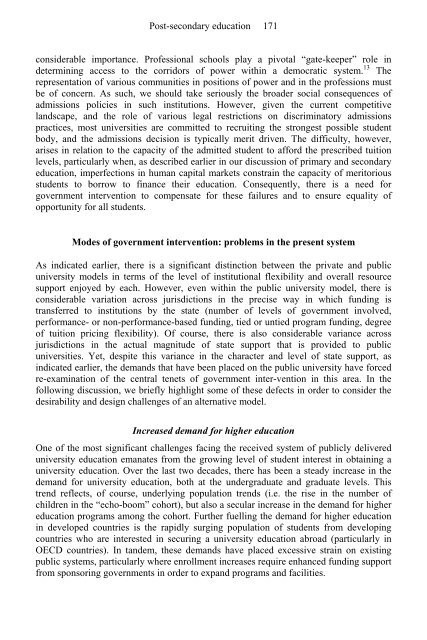Rethinking the Welfare State: The prospects for ... - e-Library
Rethinking the Welfare State: The prospects for ... - e-Library
Rethinking the Welfare State: The prospects for ... - e-Library
You also want an ePaper? Increase the reach of your titles
YUMPU automatically turns print PDFs into web optimized ePapers that Google loves.
Post-secondary education 171<br />
considerable importance. Professional schools play a pivotal “gate-keeper” role in<br />
determining access to <strong>the</strong> corridors of power within a democratic system. 13 <strong>The</strong><br />
representation of various communities in positions of power and in <strong>the</strong> professions must<br />
be of concern. As such, we should take seriously <strong>the</strong> broader social consequences of<br />
admissions policies in such institutions. However, given <strong>the</strong> current competitive<br />
landscape, and <strong>the</strong> role of various legal restrictions on discriminatory admissions<br />
practices, most universities are committed to recruiting <strong>the</strong> strongest possible student<br />
body, and <strong>the</strong> admissions decision is typically merit driven. <strong>The</strong> difficulty, however,<br />
arises in relation to <strong>the</strong> capacity of <strong>the</strong> admitted student to af<strong>for</strong>d <strong>the</strong> prescribed tuition<br />
levels, particularly when, as described earlier in our discussion of primary and secondary<br />
education, imperfections in human capital markets constrain <strong>the</strong> capacity of meritorious<br />
students to borrow to finance <strong>the</strong>ir education. Consequently, <strong>the</strong>re is a need <strong>for</strong><br />
government intervention to compensate <strong>for</strong> <strong>the</strong>se failures and to ensure equality of<br />
opportunity <strong>for</strong> all students.<br />
Modes of government intervention: problems in <strong>the</strong> present system<br />
As indicated earlier, <strong>the</strong>re is a significant distinction between <strong>the</strong> private and public<br />
university models in terms of <strong>the</strong> level of institutional flexibility and overall resource<br />
support enjoyed by each. However, even within <strong>the</strong> public university model, <strong>the</strong>re is<br />
considerable variation across jurisdictions in <strong>the</strong> precise way in which funding is<br />
transferred to institutions by <strong>the</strong> state (number of levels of government involved,<br />
per<strong>for</strong>mance- or non-per<strong>for</strong>mance-based funding, tied or untied program funding, degree<br />
of tuition pricing flexibility). Of course, <strong>the</strong>re is also considerable variance across<br />
jurisdictions in <strong>the</strong> actual magnitude of state support that is provided to public<br />
universities. Yet, despite this variance in <strong>the</strong> character and level of state support, as<br />
indicated earlier, <strong>the</strong> demands that have been placed on <strong>the</strong> public university have <strong>for</strong>ced<br />
re-examination of <strong>the</strong> central tenets of government inter-vention in this area. In <strong>the</strong><br />
following discussion, we briefly highlight some of <strong>the</strong>se defects in order to consider <strong>the</strong><br />
desirability and design challenges of an alternative model.<br />
Increased demand <strong>for</strong> higher education<br />
One of <strong>the</strong> most significant challenges facing <strong>the</strong> received system of publicly delivered<br />
university education emanates from <strong>the</strong> growing level of student interest in obtaining a<br />
university education. Over <strong>the</strong> last two decades, <strong>the</strong>re has been a steady increase in <strong>the</strong><br />
demand <strong>for</strong> university education, both at <strong>the</strong> undergraduate and graduate levels. This<br />
trend reflects, of course, underlying population trends (i.e. <strong>the</strong> rise in <strong>the</strong> number of<br />
children in <strong>the</strong> “echo-boom” cohort), but also a secular increase in <strong>the</strong> demand <strong>for</strong> higher<br />
education programs among <strong>the</strong> cohort. Fur<strong>the</strong>r fuelling <strong>the</strong> demand <strong>for</strong> higher education<br />
in developed countries is <strong>the</strong> rapidly surging population of students from developing<br />
countries who are interested in securing a university education abroad (particularly in<br />
OECD countries). In tandem, <strong>the</strong>se demands have placed excessive strain on existing<br />
public systems, particularly where enrollment increases require enhanced funding support<br />
from sponsoring governments in order to expand programs and facilities.


